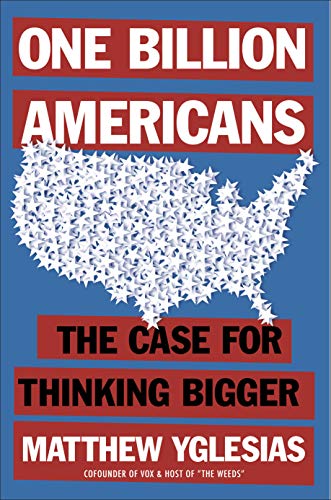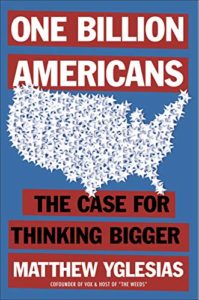

This weekend I watched a CBS Sunday Morning show that I had taped a few weeks ago. There was a fairly depressing segment on the cost of child care versus the amount of money a parent, typically a woman, could make. The solution that one of the interviewees advocated was higher government subsidies for children. She misses an opportunity and it’s the same one that Matt Yglesias missed in his 2020 book, One Billion Americans: The Case for Thinking Bigger, although he has less excuse.
I reviewed the book here. I liked it a fair amount but the book is a bit of a bait and switch. Whereas Yglesias says he wants the United States to have one billion people and understands that that would mean massive immigration, he doesn’t get into immigration in detail. He puts a lot more detail into his proposal for child subsidies even though he must realize that the number of Americans added because of the incentive effects of the subsidies would be a fraction of the number of people added by immigration.
Even more frustrating, given the book’s theme, is that he passes up the chance to get some low-hanging fruit with a two-fer: get lower cost of child rearing by allowing way more immigration of people, typically women, who would provide a lot of child care.
Here’s a relevant section of my review of his book:
For instance, he advocates having the federal government give families $3,600 upfront for every birth and then $300/month, which is $3,600 per year, until the kid hits seventeen. A numerate reader will do the math: the United States has about 70 million people less than 17 years old. Therefore, the annual cost, ignoring the $3,600 baby bonus, would be over $250 billion. That’s not a small number. With almost five million births a year, the annual cost of the bonus would be an additional $18 billion. And those numbers assumee that Yglesias’s plan doesn’t work. If it works, then births would rise and so would costs.
An important number missing from the book is what economists would call the elasticity of “supply” of children with respect to the “price” of children. Ygelsias’s purpose with the child subsidy is to bring down the perceived price of having children. A reasonable estimate is that the average amount of time spent raising children in their first 17 years is 10 hours per week, obviously front-loaded in the first few years. At even an average parental wage of $20 an hour, surely an underestimate, that’s about $10,000 per year. So his proposal would reduce the perceived price by about 36 percent. Would that lead to 10 percent more children, 50 percent more children, or some number in between? I don’t expect Yglesias to know. No one knows. But he needs to address the issue. Moreover, with my alternative proposal of having tens of millions of women from poor countries be nannies hired by parents, the price of raising kids could easily fall by 36 percent, with the huge additional benefit that the cost to the feds would be close to zero. He does cite a study that “finds that when low-skilled immigrants enter a metro area,” college-educated professional women work more hours and earn more money because they can hire housekeepers and babysitters. But he doesn’t pull the trigger and advocate letting more low-skilled workers in. Indeed, to the extent he discusses skills and immigration, it is to advocate that we get “as many smart, skilled immigrants to our shores as we possibly can.” That’s a good idea, but the U.S. government should let in many unskilled people too.
Even if allowing tens of millions of women from poor countries to be nannies would cut the price of raising kids by “only” say, 15 percent, notice the difference between that and subsidies: subsidies cost us taxpayers whereas more immigrant nannies cost little. Remember the Bryan Caplan mantra: the U.S. welfare state is aimed mainly at the old, not the young. One proposal, immigration, increases the pie; the other proposal, subsidies, shrinks it, or, more accurately, causes it to be smaller than otherwise.

READER COMMENTS
robc
May 9 2022 at 9:22pm
I thought I was reading a Caplan post until the end. Then I got confused about what site I was on.
That I could confuse the two of you is a compliment to both, I hope.
David Henderson
May 9 2022 at 9:58pm
Thanks. I’ll take it. 🙂
Thomas Lee Hutcheson
May 10 2022 at 10:47am
Rather than subsidize child care, just give parents more money with the CTC.
Yes, it would be nice to allow more low skilled laborer to immigrate, but the big gains from immigration would be if as much as possible of Matt’s extra billion people were highly skilled, talented, entrepreneurial immigrants.
Philo
May 10 2022 at 5:10pm
The U.S. government should admit 667,000,000 highly skilled, talented, entrepreneurial immigrants and also 667,000,000 ordinary, low-skilled people (to be nannies, gardeners, chauffeurs, agricultural workers, construction laborers, janitors, etc., etc.). Then the U.S. would get both sorts of benefit!
Thomas Lee Hutcheson
May 11 2022 at 8:17am
Yes, a lot of both. I don’t get the numbers you suggest. I don’t know how many high skilled immigrants we could attract. And even low-skilled I’d have a minimum amount of education and English proficiency.
nobody.really
May 12 2022 at 10:53am
People often ask whether a nation could acquire X more efficiently though domestic production or through importing things produced elsewhere. Unions often criticize this second option as “outsourcing labor.” This proves to be an unexpectedly apt description of immigration.
My tax professor posed a hypothetical about an infertile couple that was planning to incur the expense of adoption, but then canceled these expenditures when unexpectedly they were able to give birth after all. Were the resulting savings “income”? This led into a discussion about the meaning of “product of labor.”
In short, children are like the concept of profits: Some things are easier to conceive than to realize.
Comments are closed.